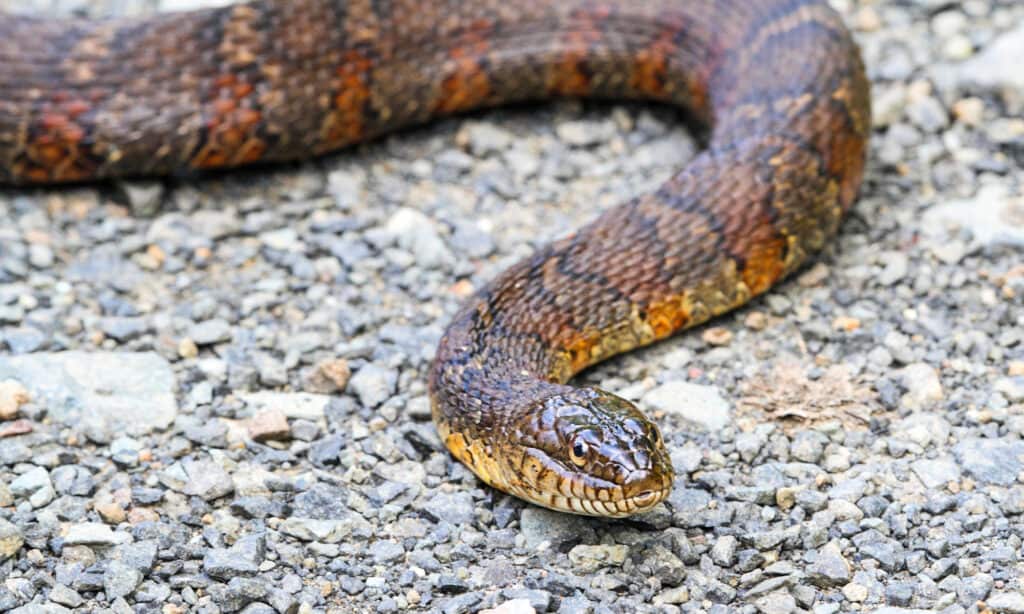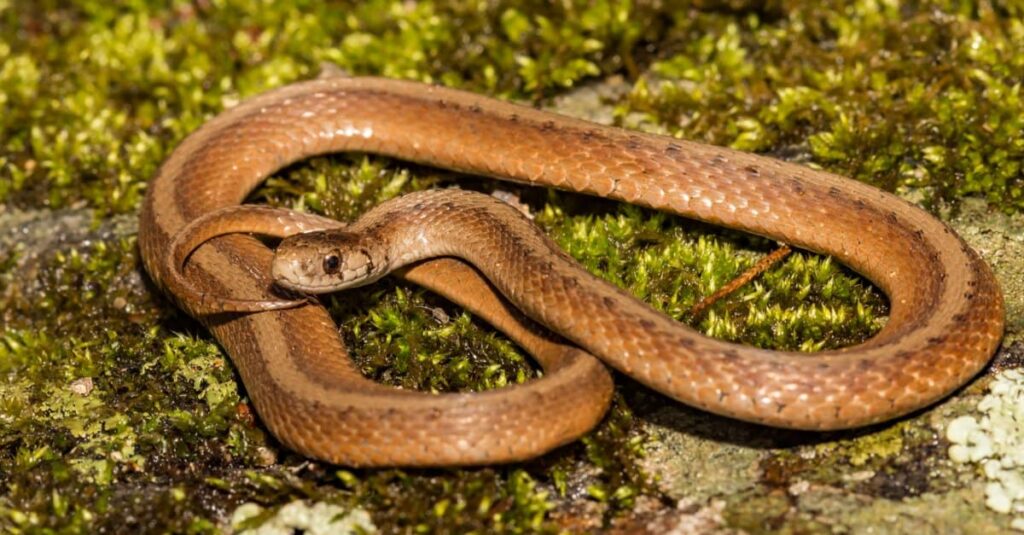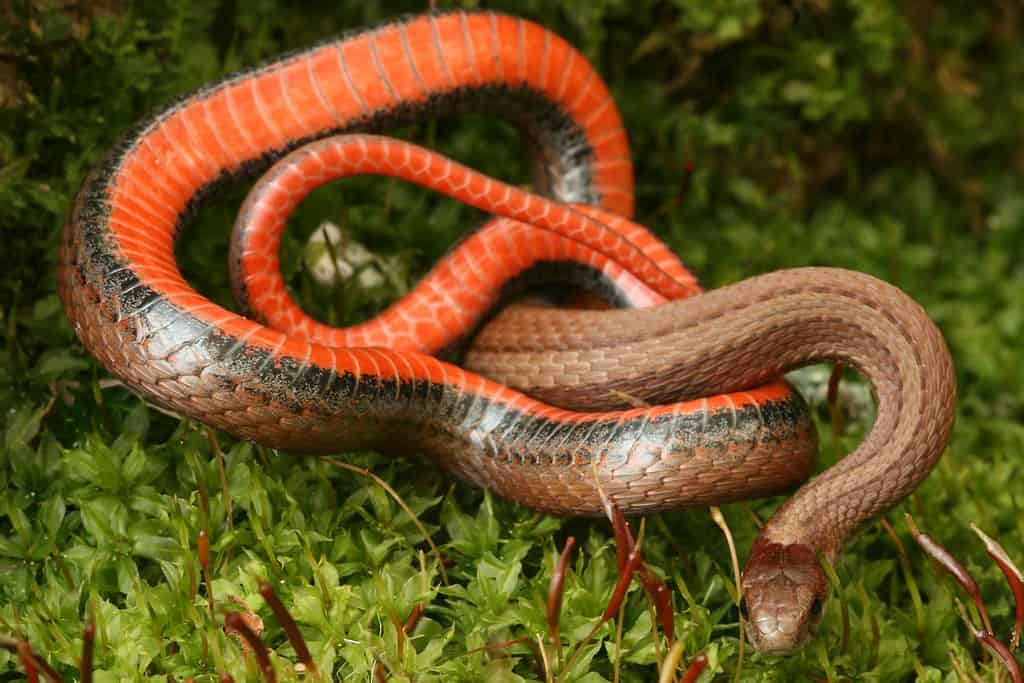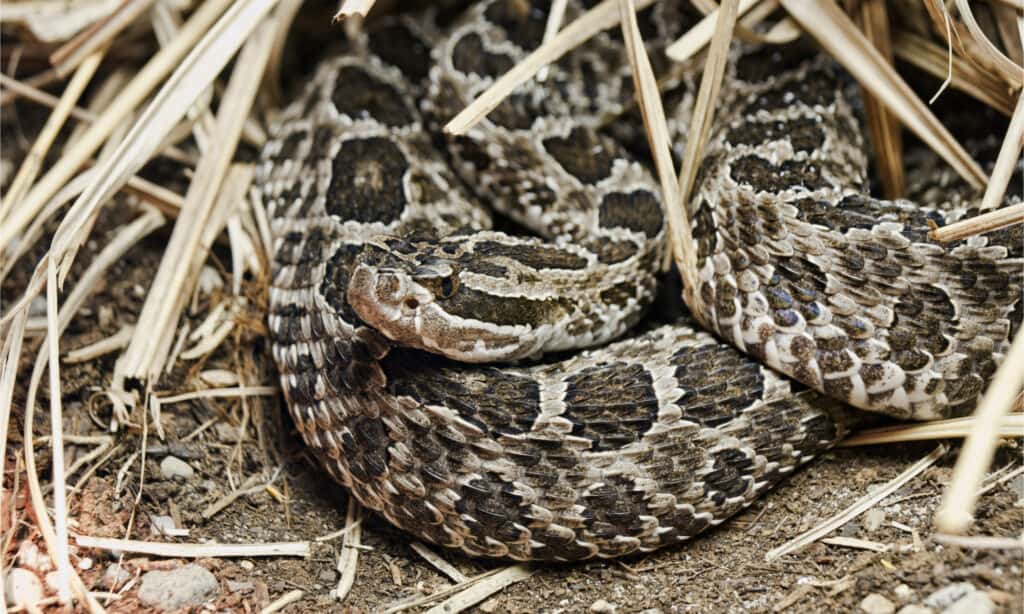
The Detroit River is a 28-mile-long river on the international border between Canada and the United States. Detroit, Michigan, sits on the northwest bank, while Windsor, Ontario, is on the southeast. It was a vital part of Detroit’s growth as the Car Capital of the United States because of its depth and width, which allowed large ships to move between Lake St. Claire and Lake Erie.
And, now that the area is getting a make-over, the habitat is recovering from nearly a century of polluted runoff. The Detroit River is an ecological success story that proves we can fix some of the mistakes we’ve made! Species that were absent for decades, like walleye fish, have returned and are breeding in and around the river. However, we aren’t talking about fish — but snakes! For the slithering Detroit River residents, read on.
1. Eastern Gartersnake (Thamnophis sirtalis sirtalis)

One of the most cold-tolerant snakes in the world, garter snakes are usually active early and later in the year than other species.
©Erik Agar/Shutterstock.com
Easily the most common snake lurking about the shores of the Detroit River, the eastern gartersnake is semiaquatic, spending hours in the water.
These snakes are highly tolerant of many habitats, including human-made. They’ll eat anything they can overpower but prefer toads, frogs, slugs, and worms.
Eastern garter snakes are the most common snake slithering around the Detroit River. They measure between two and four feet long and are thin with smallish heads and big, friendly eyes.
This harmless snake has mild venom that helps them incapacitate their prey but doesn’t hurt people. One easy way to tell if it’s a garter snake (sometimes the exact species is a challenge) is by looking for three lines that run the length of its body — one dorsal and one on each flank. The stripes vary from white to orange and every shade in between — some even have red stripes. With a darker base color of brown to olive, those stripes really stand out!
2. Common Water Snake (Nerodia sipedon)

Northern watersnakes are one of the most widespread watersnakes in North America.
©Steve Byland/Shutterstock.com
A heavier-bodied snake, the common water snake sometimes gets confused with venomous cottonmouths. However, there aren’t any cottonmouths in Michigan, so you’re likely safe.
Common water snakes are almost as common in and around the Detroit River as eastern garter snakes. Another harmless species, common watersnakes, eat fish and amphibians. To help grab and hold their slippery prey, they have razor-sharp teeth.
This species averages two to three feet long but rarely reaches four. They have reddish-brown cross bands over a lighter base color but lose the pattern as they mature. Common water snakes sometimes become almost black but retain the vertical bars around their lips.
A shy species, common watersnakes are semi-aquatic and usually take off at the first sign of danger. However, if you try to grab one, it will use those wickedly sharp teeth to defend itself!
3. Dekay’s Brown Snake (Storeria dekayi)

De Kay’s brown snake is found in most of eastern half of the United States.
©Jay Ondreicka/Shutterstock.com
Also called the brown snake, these tiny little reptiles are common in the eastern half of North America. A massive one will measure 12 inches long, and the record is 19 3/8″.
It has a light dorsal stripe and brown body color. Sometimes it has dark spots on either side of the stripe, but sometimes it’s more solid-colored. This species is harmless and eats worms, slugs, and snails. Dekay’s brownsnakes aren’t aquatic but love moist areas that you’d find around the edges of rivers. So, pick up a few damp logs, and you may find some snakes hanging out underneath.
4. Red-Bellied Snake (Storeria occipitomaculata)

Red-bellied snakes are harmless slug and snail eaters.
©Kevin Collison/Shutterstock.com
This two-toned snake is gray, orange, black, or brown on its dorsal side but sports a bright red or orange belly. Red-bellied snakes measure between four and 10 inches long; they’re common near the Detroit River, although you may never see one.
A close cousin to Dekay’s brown snake, the red-bellied snake is also tiny and measures between four and 10 inches long. It also enjoys many of the same foods and hangout spots. Red-bellied snakes can’t burrow, so they use old anthills for shelter. You’ll also find these snakes hiding under moist leaf litter during warmer seasons.
5. Eastern Foxsnake (Pantherophis vulpinus)

Western fox snakes tend to prefer dryer habitats.
©Psychotic Nature/Shutterstock.com
Eastern foxsnakes are rat snakes in areas east of the Mississippi River and inhabit Michigan and a few other northern states. Like other rat snakes, eastern foxsnakes are long and can measure up to six feet. They have dark brown spots over a light golden brown base, and their bellies look like checkerboards.
This nonvenomous species is an excellent climber but usually hunts on the ground. Eastern foxsnakes typically prey on rats and mice but will eat anything they can shove in their mouths.
Master bluffers, an eastern foxsnake will coil up, rattle its tail in leaf litter, and strike at threats. However, once it realizes it isn’t in danger, it calms down pretty quickly.
6. Eastern Massasauga (Sistrurus catenatus)

Massaugas are the only venomous snake in Michigan.
©DnDavis/Shutterstock.com
One snake that sometimes slithers near the Detroit River is venomous. It’s one of the smallest rattlesnake species in the world and only measures between 24 and 30 inches.
However, don’t let that small size fool you. This venomous snake is dangerously venomous, and a bite can send you to the hospital needing antivenom. Luckily, it’s not aggressive and avoids people whenever possible. Bites usually only happen when someone deliberately handles or accidentally steps on one.
Eastern massasaugas have small rattles that produce higher-pitched buzzing sounds. Like all rattlesnakes, they’re pit vipers with a heat-sensing pit between their nostril and eye. In addition, these snakes have dark brown or black oblong blotches along the center of their back and smaller ones on the sides.
They’re rare in Michigan and listed as a species of “special concern.”
Is It Safe to Swim in the Detroit River
In the early 1900s, it helped Detroit grow into one of the largest American cities, but that popularity had a cost — pollution from PCBs, metals, oils and greases, and bacterial overgrowth made some of the water undrinkable and uninhabitable for many species and not swimmable for people.
As a result, beach closings, water consumption limitations, and wildlife habitat loss were common.
However, according to AmericanRivers.org, local and federal authorities have worked hard to clean up the river. As a result, the river’s generally safe to swim in most areas. Local authorities test the water regularly to ensure swimmers’ safety and to monitor the recovery process. The results are showing up in surprising ways!
Animals that Live Along the Detroit River
Thanks to the clean-up efforts, species that hadn’t been seen for nearly 100 years started showing up again, and you can now see walleyes and whitefish, in addition to several more animals:
Lake Sturgeon
These primitive fish can weigh up to 240 pounds and live up to 150 years. A record lake sturgeon caught in the Detroit River in 2021 was likely over 100 years old.
Peregrine falcons
In 1986, Michigan began work to save the peregrine falcon population. As of 2016, there were 13 nest sites in southeast Michigan near Detroit.
Beavers
Once hunted to extinction, beavers have a growing population again. They’re now in at least six watershed areas of the Detroit River.
What Happens if You See a Snake Underwater?
Fortunately, the only venomous Michigan snake is the eastern Massasauga. While all snakes can swim, only some spend significant time in the water.
If you see a snake in the Detroit River, it’s most likely a garter or water snake. However, snakes are more worried about you hurting them! So give snakes some room, and they’ll leave you alone and keep the rodent population down.
Summary of 6 Snakes Slithering Around the Detroit River
| Rank | Snake |
|---|---|
| 1 | Eastern Gartersnake (Thamnophis sirtalis sirtalis) |
| 2 | Common Water Snake (Nerodia sipedon) |
| 3 | Dekay’s Brown Snake (Storeria dekayi) |
| 4 | Red-Bellied Snake (Storeria occipitomaculata) |
| 5 | Eastern Foxsnake (Pantherophis vulpinus) |
| 6 | Eastern Massasauga (Sistrurus catenatus) |
The photo featured at the top of this post is © iStock.com/Simplyphotos
Discover the "Monster" Snake 5X Bigger than an Anaconda
Every day A-Z Animals sends out some of the most incredible facts in the world from our free newsletter. Want to discover the 10 most beautiful snakes in the world, a "snake island" where you're never more than 3 feet from danger, or a "monster" snake 5X larger than an anaconda? Then sign up right now and you'll start receiving our daily newsletter absolutely free.
Thank you for reading! Have some feedback for us? Contact the AZ Animals editorial team.






